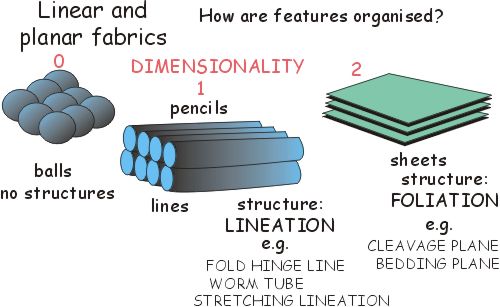
All materials can be considered on a grain scale as follows. If it has no fabric the rock "looks" the same in all directions. It is said to be isotropic. Classic igneous textures are examples of this (a "salt and pepper" texture where the grains are sprinkled randomly through the rock without any particular alignment). However if it has a structure so that mineral grains are aligned in some way the rock is termed anisotropic. But there are different types of anisotropy defined by grain shapes. Rocks can contain planar fabric - shape or location. The fabric is 2D in a 3D world. This is sometimes called a foliation. But rocks can also have a linear fabric - 1D in a 3D world. This is called a lineation. These are fundamental differences and generally can only be distinguished by looking at the 3D structure (perhaps by comparing views from differently-oriented 2D surfaces on the specimen or outcrop).
